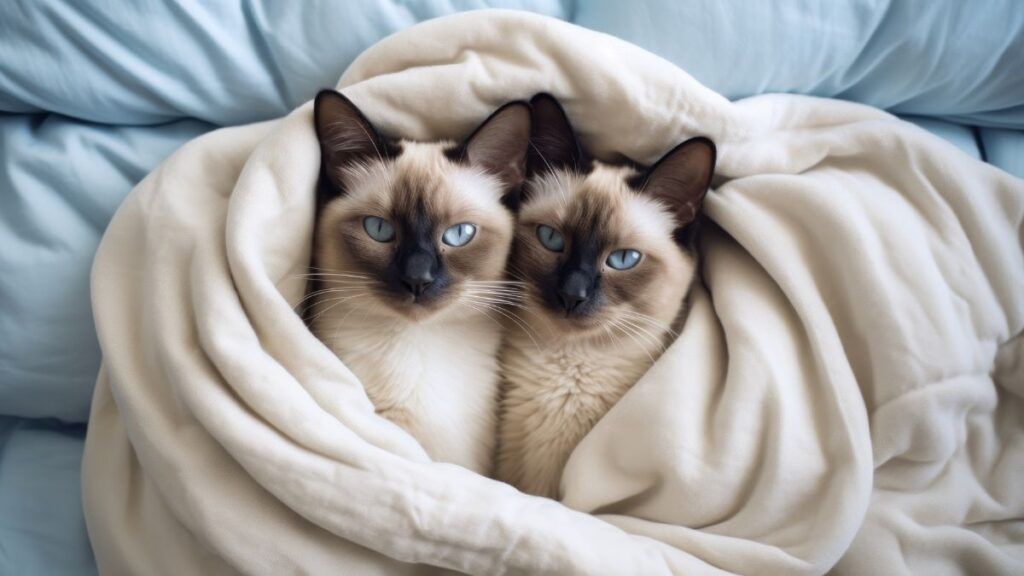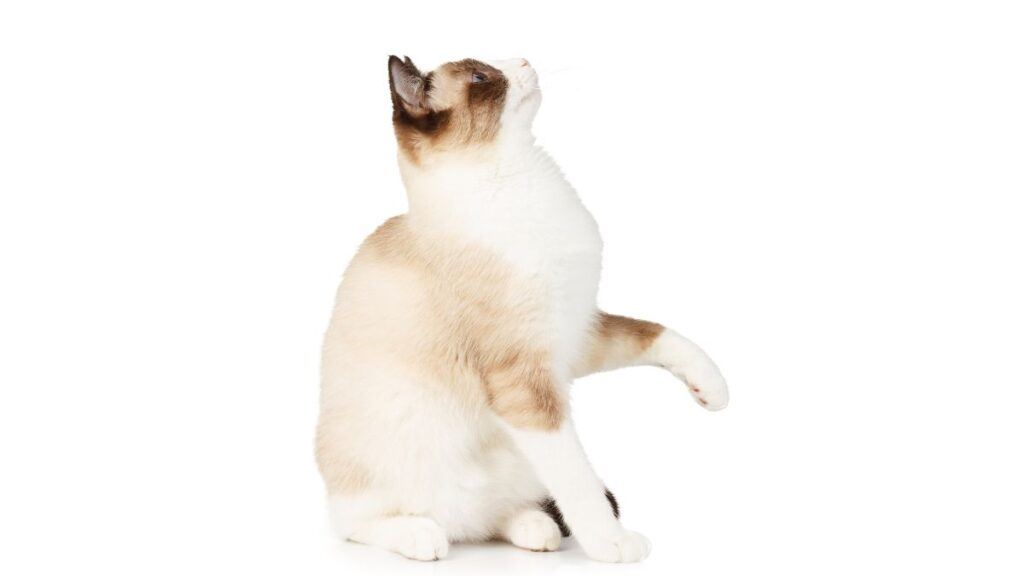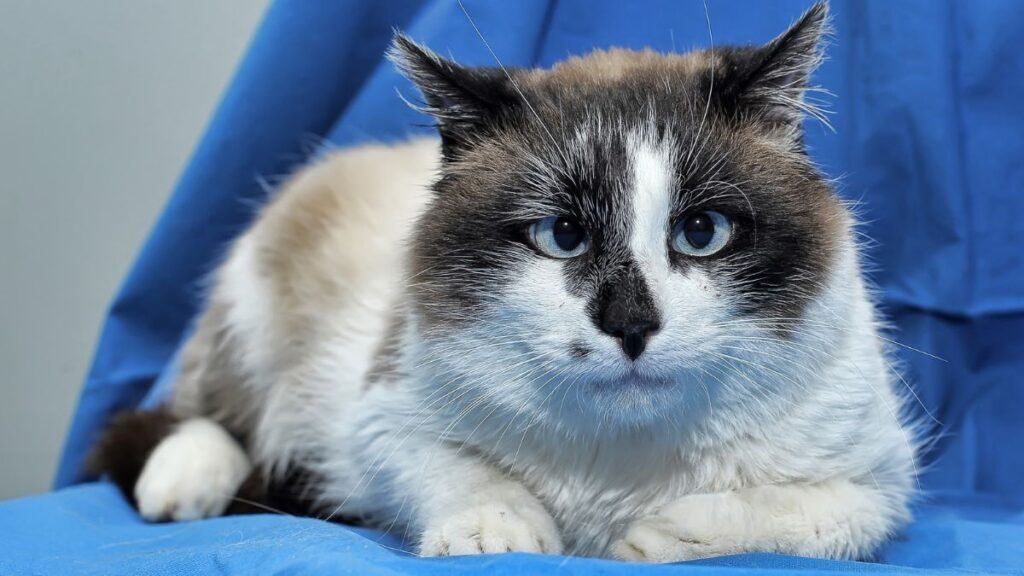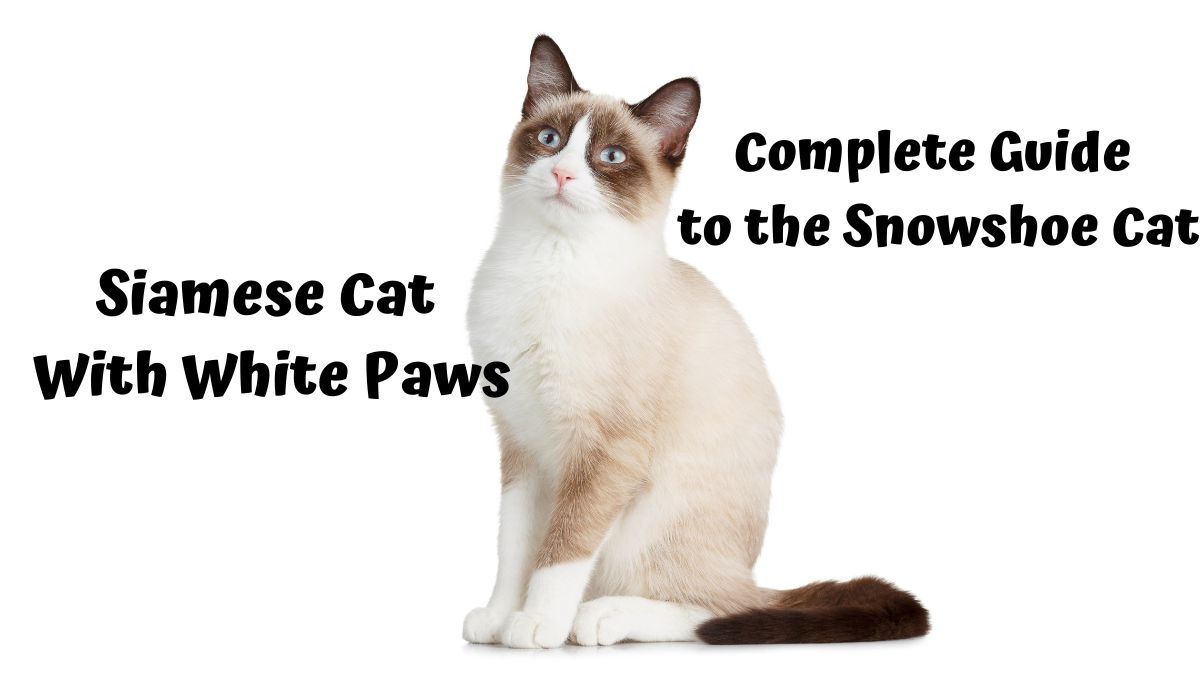Discover the enchanting world of the Siamese breed, a group of intelligent cats known for their distinct coat patterns and bright blue eyes.
Among these, the Siamese cat with white paws, often seen in the Snowshoe breed or as a Snowshoe mix cat, stands out for its unique charm and elegance.
This article delves deep into the characteristics of these cats, including popular variations like the seal point Siamese, lilac point, and chocolate point, and explores the special care they require.
Whether you’re considering adopting a Siamese cat or simply curious about their unique white paws, this guide aims to provide comprehensive and credible information.
Join me as we explore the intriguing world of Siamese cats with white paws – a journey through their history, care, and the special bond they share with their human companions.
Understanding Siamese Cats

The Siamese breed, one of the most intelligent cats and recognized cat breeds, originated in Thailand (formerly Siam).
These medium-sized cats, including the traditional Thai cats and the modern Siamese ancestors, are known for their bright blue eyes and distinctive color patterns.
Physical Characteristics and Personality Traits
Siamese cats, particularly the seal point Siamese and chocolate point varieties, are celebrated for their elegant body type and sociable nature.
The breed standards set by the Cat Fanciers’ Association emphasize their sleek, short-haired coats and striking coat colors.
These cats are also renowned for their slender, muscular bodies, large ears, wedge-shaped heads, and striking blue almond-shaped eyes.
Their unique ‘points’—darker colors on the ears, face, paws, and tail—create a beautiful contrast with their lighter body color.
These cats are famously vocal, using distinctive, low-pitched meows to communicate.
Their friendly, intelligent, and affectionate nature makes them beloved companions, though they dislike being alone for extended periods.
Siamese Cats in Culture and Folklore
The Siamese breed, including variations like the lilac point and the unique snowshoe Siamese cats, has been a symbol of beauty and intelligence in different cultures.
These social cats are often featured in art and literature, highlighting their distinct coat pattern and kinked tail.
The White Paws Phenomenon in Siamese Cats

The white paws in some Siamese cats, often seen in the Snowshoe breed, result from a unique genetic interplay affecting their coat pattern.
This trait, distinguishing them from other Siamese cats, adds to the breed’s diversity.
Siamese cats display a form of partial albinism resulting from a temperature-sensitive enzyme influencing coat color.
Typically, this results in darker colors on the more distal parts of their body – the ears, face, paws, and tail.
However, the presence of white paws suggests additional genetic factors at play, possibly linked to piebald or white spotting genes.
These genes interrupt the typical coloration patterns, leading to the charming and distinctive white “gloves” or “socks” seen in some Siamese cats.
Appearance and Health Considerations
While primarily a cosmetic trait, the white paws in these intelligent cats don’t typically affect their health.
Owners should be aware of common breed-specific issues like kidney disease and progressive retinal atrophy.
The aesthetic appeal of white paws on a Siamese cat adds a unique charm to their already striking appearance.
From a health perspective, these white markings are generally just a cosmetic variance and do not typically indicate any underlying health concerns.
However, as with all Siamese cats, those with white paws should be monitored for common breed-specific issues such as kidney disease and progressive retinal atrophy. .
Comparison with Traditional Siamese Markings
The white-pawed Siamese often resembles a separate breed but is a delightful variation within the Siamese breed.
This variation showcases the breed’s rich genetic traits, which includes different breeds like the bicolor American Shorthairs.
While traditional Siamese cats are known for their uniform color points, the white-pawed Siamese stands out for its rarity and distinctive look.
It’s important to note that this variation does not affect the cat’s personality or health differently than the standard Siamese.
Cat enthusiasts and potential owners should appreciate this variation as a unique expression of the breed’s diverse genetic makeup.
Caring for a Siamese Snowshoe Cat

These short-haired cats, particularly those with a Snowshoe mix, require minimal grooming compared to long-haired breeds.
Their coat pattern, including the white paws, should be regularly cleaned to maintain their pristine appearance.
However, their white paws may need extra attention to keep them clean and pristine.
Regular brushing helps remove loose hair and reduce shedding, while occasionally wiping the paws with a damp cloth can prevent dirt build-up.
It’s also important to regularly check and clean their ears, trim their nails, and ensure good dental hygiene.
Diet and Nutrition
A balanced diet is vital for these medium-sized cats, with a focus on maintaining their sleek body type and preventing common health issues like kidney disease.
High-quality cat food that meets their nutritional needs, including proteins, fats, vitamins, and minerals, is essential.
Siamese cats can be prone to obesity, so it’s essential to monitor their food intake and provide a diet appropriate for their age, activity level, and health conditions.
Fresh water should always be available to support their hydration needs.
Exercise and Mental Stimulation
Siamese cats, known for being social cats, need regular exercise and mental stimulation to stay healthy and engaged.
Their intelligent nature makes them ideal family members, thriving on interaction and play.
Interactive toys, climbing trees, and regular playtime can help channel their energy positively.
Since Siamese cats are highly social, they thrive on attention and engagement with their human companions.
Puzzle feeders and toys stimulating their hunting instincts can also benefit mental stimulation.
Veterinary Care and Monitoring
Regular veterinary check-ups are essential to ensure your Siamese cat’s overall health and well-being.
This should include routine vaccinations, parasite control, and health screenings, primarily focusing on common breed-specific issues like dental, heart, and respiratory problems.
Early detection and treatment of any health concerns are critical to your Siamese cat’s long, healthy life.
Related: Siamese Maine Coon Mix
Health and Well-being of Siamese Cats with White Paws

Common Health Issues in Siamese Cats
Siamese cats including variations like the Snowshoe Siamese cats are generally healthy, but like all breeds, they have predispositions to specific health conditions.
Awareness and proactive care are essential. Common issues include:
- Respiratory Problems: Some Siamese cats may experience respiratory issues due to their slender faces. Regular check-ups can help detect any early signs of problems.
- Dental Diseases: Siamese cats are prone to dental issues. Maintaining good oral hygiene through regular brushing and veterinary dental check-ups is crucial.
- Heart Conditions: Conditions like hypertrophic cardiomyopathy, a form of heart disease, are known to affect Siamese cats. Regular veterinary visits and echocardiograms can help monitor heart health.
Nutrition and Weight Management
A nutritious diet is crucial for these cats, ensuring they maintain their characteristic body type and coat colors.
Given their propensity for obesity, it’s essential to manage their diet carefully.
High-quality cat food, portion control, and avoiding excessive treats can help maintain a healthy weight. Regular play and exercise also contribute to keeping them fit.
Behavioral Health
As highly social cats, Siamese cats require emotional and social engagement to maintain their well-being. Neglect can lead to stress and behavioral issues.
Siamese cats’ mental and emotional well-being is as important as their physical health.
Lack of attention can lead to stress and behavioral issues. Interactive play, puzzle toys, and regular engagement can help keep them mentally stimulated and emotionally satisfied.
Preventative Health Measures
Preventative care plays a vital role in the long-term health of Siamese cats. This includes:
- Regular Vaccinations: Keeping up with vaccinations helps prevent various infectious diseases.
- Parasite Control: Regular treatments for fleas, ticks, and worms are essential.
- Spaying/Neutering: This not only prevents unwanted litters but also reduces the risk of certain health issues.
Special Considerations for White Paws
The white paws of a Siamese cat do not typically require special medical attention. Still, it’s important to keep them clean to avoid any infections, especially if they are outdoor explorers.
Regular inspections for cuts, thorns, or swelling can help in the early detection of potential issues.
Related: Striped Siamese Cat
Adoption and Breeding Information
When adopting or engaging in a breeding program for Siamese cats, including the Snowshoe breed or other color pattern variations, it’s essential to follow ethical practices.
Reputable breeders who prioritize their cats’ health, well-being, and genetic diversity should be your go-to choice.
They should provide comprehensive health records and allow you to visit their breeding facility to observe the conditions.
Alternatively, adopting from shelters or rescue organizations can be a rewarding experience, as many Siamese cats, including those with unique traits like white paws, await loving homes.
Choosing the Right Siamese Cat
Consider the cat’s personality, coat colors, and whether it fits as a new member among your family members.
Siamese cats are known for their affectionate and friendly nature but require significant attention and interaction. Ensure you are ready for a long-term commitment to their care and companionship.
Preparing for a Siamese Cat’s Arrival
Before your Siamese cat arrives, prepare your home to make it safe and welcoming.
This includes securing potentially dangerous items, setting up a feeding area, a comfortable bed, a litter box, and cat-friendly toys.
It’s also advisable to have a vet appointment scheduled for a health check-up soon after their arrival.
Understanding the Commitment
Owning a Siamese cat, especially one with unique features like white paws, is a significant commitment.
These cats often live into their late teens or early twenties, requiring consistent care throughout their lives. Understanding this commitment is essential for ensuring your cat’s happy and healthy life.
Building a Supportive Community
Connecting with other Siamese cat owners through clubs, online forums, or local communities can be incredibly beneficial.
These communities offer support, advice, and the opportunity to share experiences and knowledge about the breed.
Related: Cinnamon Siamese Cat
Living with a Siamese Cat
Bonding and Building a Relationship
Siamese cats are known for their strong bonding capabilities. These intelligent and social cats form deep bonds with their owners.
Understanding their behavior, including their unique color pattern and vocalizations, is key.
Building this bond involves spending quality time together, engaging in play, and understanding their unique vocalizations and body language.
Consistent, gentle interaction from an early age (or from the time of adoption) is key to developing a trusting and loving relationship.
Social and Emotional Needs
Siamese cats, especially those resembling different breeds like the Snowshoe mix cat, thrive on social interaction with their human family members.
They do not do well with prolonged solitude.
If you’re away from home frequently, consider having a companion for your Siamese cat or arranging for a pet sitter or a family member to spend time with them.
Their emotional well-being is as important as their physical health; they need regular engagement and affection.
Integration with Family and Other Pets
These cats, known for their sociable nature, generally integrate well with other family members and pets, including dogs and other cats maintaining the harmony of their social environment.
Early socialization is beneficial for easing any potential tensions. Monitoring their interactions initially and providing each pet with their own space is essential.
Activity and Enrichment
Due to their high energy levels and intelligence, Siamese cats require ample stimulation. To keep them engaged, provide various toys, climbing structures, and interactive play sessions.
Encourage their natural behaviors like climbing and exploring to stimulate them physically and mentally.
Sharing and Celebrating Their Unique Traits
The white paws of a Siamese cat are a unique and charming characteristic.
Celebrate this feature by sharing photos and stories in cat enthusiast communities, social media groups, or with friends and family.
This spreads joy and raises awareness about the breed and its unique qualities.
Learning from Other Siamese Cat Owners
Engaging with other Siamese cat owners can provide valuable insights and tips on caring for your cat.
Whether through online forums, social media groups, or local clubs, these communities can offer support advice and share experiences that can enrich your journey as a Siamese cat owner.
Embracing the Journey with a Siamese Cat with White Paws
As we conclude this exploration into the world of Siamese cats with white paws, it’s clear that these felines are more than just pets.
They are companions with distinct personalities, unique needs, and an ability to form deep, meaningful bonds with their owners.
The journey with a Siamese cat, particularly one with the rare beauty of white paws, is filled with joy, challenges, and endless learning.
From understanding their rich history and distinctive characteristics to providing them with the proper care, nutrition, and environment, owning a Siamese cat is a rewarding experience that requires commitment and love.
Remember, these cats thrive on attention and affection, making them ideal companions for those who can dedicate time and energy to their well-being.
Introducing Cory Haasnoot, a devoted father, loving husband, and enthusiastic cat lover. As a key content creator for CatFurLife.com, Cory blends his family values and passion for felines into engaging and informative content. He brings a unique perspective to the site, sharing cat care tips and how cats can enrich family life and bring joy to households.

